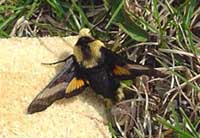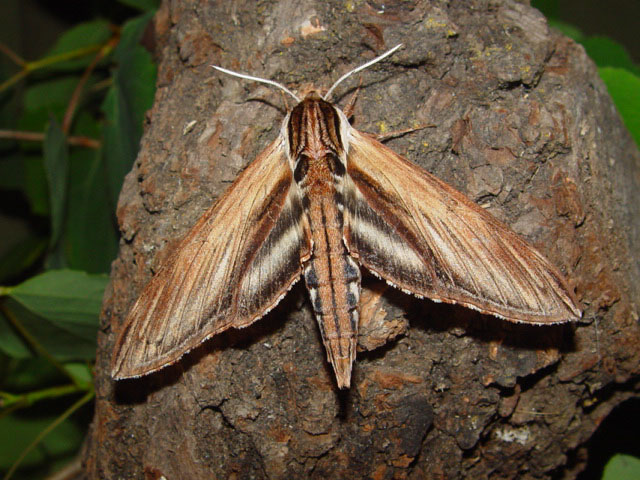Sphinginae subfamily
Sphingini tribe:
 |
This species is a strong migrant and adults nectar from deep-throated
flowers including moonflower (Calonyction aculeatum),
morning glory (Convolvulus), honey suckle (Lonicera)
and petunia (Petunia species).
|
 |
Ceratomia amyntor
WO,
the Elm Sphinx or Four-horned Sphinx
The upperside of the forewing is brown with dark brown and white
markings including a white costal area near the wing base, dark
streaks along the veins, and a white spot in the cell.
Larvae feed on Elm (Ulmus), birch (Betula), basswood (Tilia), and
cherry (Prunus).
|
 |
The upperside of the forewing is yellowish brown with no white
markings, but there are indistinct black lines and dashes. The cell
spot is gray with a black outline and the upperside of the hindwing
is yellowish brown with obscure lines. Catalpa is the larval
host.
|
 |
The upperside of the forewing is pale brownish gray with wavy black
and white lines and a black-outlined white cell spot.
|
 |
The upperside of the forewing is dark brown with a dusting of white
scales. Some moths have patches of reddish or yellowish brown on the
wings. Larve are not limited to pawpaw.
|
 |
The upperside of the forewing is gray with heavy black bands. The
upperside of the hindwing is brownish gray with no markings.
|
 |
This moth is now confirmed from York, and it is widely reported in
New Jersey and along the coast in Connecticut and Masachusetts.
If you've got pines, this species is likely present. |
 |
Forewing upperside is gray-brown with wavy lines, black dashes, and one or two small white spots near center of
the costa. Hindwing upperside is black with two white bands and a triangular black patch at the base. Note the golden hair on the thorax.
|
 |
Manduca quinquemaculatus
WO the Five-spotted Hawkmoth
The moth abdomen usually has five but sometimes six pairs of yellow
bands. The upperside of the forewing is blurry brown and gray.
I suspect if you grow tomatoes you have encountered it.
|
 |
The abdomen of the adult moth has three pairs of yellow spots. The
upperside of the forewing is yellowish brown to deep chocolate brown
with a dusting of white scales and zigzagged black and white lines.
unlikely
|

|
Sphinx canadensis
WO,
Sphinx canadensis, the Canadian Sphinx, is not common, and is not
often reported anywhere,
but it is reported in nearby Penobscot County.
Larval hosts are white ash (Fraxinus americana) and blueberry
(Vaccinium).
|
 |
Sphinx chersis
WO, the Northern Ash Sphinx or Great Ash Sphinx
The upperside of the forewing is soft dark gray to blue-gray with
a series of black dashes, one of which reaches the wing tip.
|
 |
Sphinx drupiferarum
WO/MA, the Wild Cherry
Sphinx
Forewings, long and slender, are held close to the body when the
moth is at rest. We have them on P.E.I., but I do not see them nearly as frequently
as I see the other Sphingidae. |
 |
The lower forewings are predominantly brownish-yellow with a fairly
wide dark bar along the inner margin. At rest the wings hug the body,
giving the moth a long slender look.
|
 |
Sphinx luscitiosa
WO,
the Canadian Sphinx or
Clemen's Sphinx
The upperside of the forewing is yellowish gray in males and pale
gray with a faint yellow tint in females. It seems to be an uncommon
species. |
 |
If you have blueberries in the woods, then you probably have the
Poecila Sphinx.
They are pretty common here on Prince Edward Island, but don't fly
too far south of Massachusetts, being replaced by Sphinx gordius
in Connecticut. |
Smerinthini Tribe:
 |
The adults are also highly variable; sometimes wings of an individual
may be all one color or may have several colors, ranging from pale to
dark brown, and may have a white or pink tinge.
See the file for the female; she is different. |
 |
Pachysphinx modesta
USGS/MA, the Modest Sphinx or Poplar Sphinx
This moth has a large, heavy body, and females can be remarkably plump.
They are common on Prince Edward Island. |
 |
Named for the dull grey-blue spot in the hindwing, this moth has a
wide distribution and is probably common in York County.
I regularly see them on Prince Edward Island, and they are reported as far south as Florida. |
 |
Named for the small eye-spot in the hindwing, this moth has a wide
distribution and is probably present in Sagadahoc, although not
confirmed.
I regularly see them on Prince Edward Island, and they are reported
as far south as Florida.
|
 |
This species probably flies throughout Maine.
At my home in Montague, P.E.I., Canada, they are quite common. |
 |
This moth is widely distributed and fairly common so I suspect it is
in York County.
Along the East Coast, it flies from P.E.I. to Florida. |
Macroglossinae subfamily
Dilophonotini tribe:
See Hemaris comparison to help distinguish
the next three species.
 |
Hemaris thysbe
USGS/MA, the Hummingbird Clearwing
It is not difficult to see why many gardeners would mistake an
Hemaris thysbe moth for a small hummingbird as it hovers,
sipping nectar from flowers through a long feeding tube.
|
 |
Hemaris diffinis
USGS/MA, the
Snowberry Clearwing or Bumblebee Moth
Adults mimic bumblebees and are quite variable. The wings are basically clear, with dark brown to
brownish-orange veins, bases and edges. The thorax is golden-brown to
dark greenish-brown. The abdomen tends to be dark (black) with 1-2
yellow segments before the tip.
|
 |
Hemaris gracilis
WO, the
Slender Clearwing or Graceful Clearwing
Hemaris gracilis is distinguished from similar species by a pair of
red-brown bands on the undersides of the thorax, which varies from
green to yellow-green dorsally and sometimes brown with white
underneath.
|
Philampelini tribe:
 |
Larvae get large and feed on grape vines and Virginia creeper.
Note the differences between this moth and the Pandorus Sphinx. |
 |
If you have Grape or Virginia Creeper nearby, then you probably have
this species.
I often get asked to identify larvae from areas not
previously reported. |
Macroglossini tribe:
 |
This day flier is widely distributed. If you have Virginia Creeper,
you probably have the Nessus Sphinx.
Two bright, distinct,
narrow yellow bands are often visible on the abdomen.
|
 |
They are common in New Jersey and common
here on Prince Edward Island.
You will often see this species listed as Darapsa pholus,
especially in older literature. |
 |
Darapsa myron
USGS/MA, the Virginia Creeper Sphinx or the Grapevine Sphinx
This moth is recorded on the U.S.G.S. site for York County,
but it is widely reported as far north as southern Maine. If you have
the foodplants indicated in the common names, you may have this species nearby. |
 |
If you have hydrangea growing near a stream, then you may have the
Hydrangea Sphinx.
I am actualy surprised by this record as this
species has a range generally more to the south.
|
 |
Hyles gallii
WO, the Bedstraw Hawk Moth
or Gallium Sphinx
This species is not officially reported in Sagadahoc County.
Some years I see them on P.E.I., some years, I do not.
|
 |
Hyles lineata
USGS, the White-lined Sphinx
This species is officially reported from York County.
It is a strong migrator from the south,
and there are records from the west and to the north. |
 |
This species is reported from nearby Penobscot County.
Adults fly as a single brood from April-June in meadows in coniferous
forests. Adults fly during the afternoon.
|
 |
This moth is very much under reported. It is a
rapid day flier so is probably not in too many collections.
Grape is a popular larval host.
|
|
|

